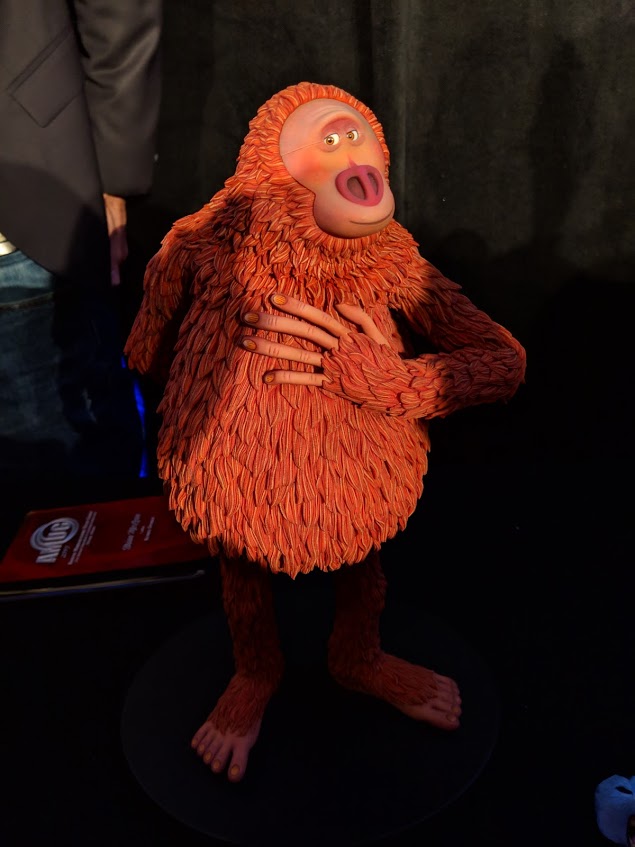Missing Link,美国定格动画工作室的最新电影莱卡, will be hitting U.S cinemas this week, and it features 3D printed models made usingCuttlefish软件,来自德国的3D打印机驱动程序Fraunhofer Institute for Computer Graphics Research(Fraunhofer IGD).
The studio used Cuttlefish to maintain the consistency of its 3D printed models for the film, creating over 100,000 detailed color 3D faces in conjunction with theStratasys J7503D printer. Missing Link is the fifth stop-motion feature from LAIKA studios, with all previous films havingutilized 3D printing也是。

3D印刷行业最近了解到,由于Amug活动中的偶然遇到的机会,Laika最终为此目的部署了墨鱼。
The collaboration between LAIKA and Stratasys to 3D print the characters for the Missing Link film has been nominated by our readers for theCreative Use of 3D printingcategory in our2019 3D印刷行业奖. You can在这里投票, as well as view other nominations and categories, where the Stratasys J750 3D printer is also up for an award.
“We have used 3D printers for our stop-motion movies since Coraline, LAIKA’s first film”, explained Brian McLean, LAIKA’s Director of Rapid Prototype. “For our current production Missing Link, we leveraged Fraunhofer IGD technologies because they are unrivalled in terms of color consistency and geometric accuracy.”
“The combination of Cuttlefish software and Stratasys J750 hardware has allowed us to produce the most sophisticated colored 3D prints ever.”

Reproducing an object’s appearance using 3D printing
Fraunhofer IGD’s Cuttlefish software is a voxel-based universal 3D printer driver, which works simultaneously with multiple printing materials to reproduce an object’s appearance, accurately capturing the shapes, colors and subtle color transitions of the original model. The software is also able to account for the dispersion of light transmitted through an object, and the changes in hue and surface textures in accordance with incidental light, in order to produce translucent objects as well.

Large amounts of data is required in order to accurately position input material to reproduce geometric and visual attributes. Cuttlefish thus streams the data, processing only that which is required for the 3D print, in order to save memory and prepare large 3D models for print quickly. The software has applications in various sectors, including medicine and automotive, and is often used to manufacture prototypes, end-products and replicas.

保持丰富多彩的一致性
In order to create its stop-motion film Missing Link, LAIKA printed a multitude of elaborate models and manipulated them with minimal movements for each scene, including subtle changes in facial expression for each individual character. The film uses 24 still frames to capture one second of movement, in order to create the smooth stop-motion effect of the film.
However, a hurdle of the process was ensuring that the colors of each face seamlessly matched the ones used in previous frames, as each different facial expression requires a new model. The Cuttlefish software from Fraunhofer IGD was identified to overcome this problem, due to its ability to maintain the required color consistency in the reproduction of the faces when 3D printing. LAIKA used the Cuttlefish 3D printer driver in conjunction with several Stratasys J750 3D printers to create 106,000 highly detailed color 3D faces for the Missing Link film.

An award-nominated collaboration
莱卡is distinguished for its use of3D printing in its stop-motion films,与领先的3D打印机OEM合作Stratasys为此previous films也是。为了电影Kubo and the Two Strings, the pair collaborated to 3D print 64,000 3D printed faces in total for its characters. However, Missing Link is the first film by LAIKA to utilize the Cuttlefish 3D printer driver from Fraunhofer IGD. A total of 106,000 production faces were produced for Missing Link.
莱卡has also worked with footwear giantNiketo produce the缺少链接X Nike Air Max Susan鞋, inspired by the Missing Link character, ‘Mr. Susan Link’, which was manufactured in part using 3D printing.
You can now cast your vote for the third annual3D Printing Industry Awards, where Stratasys and LAIKA are up for consideration. Help decide this year’s winnersnow.
Subscribe to the3D Printing Industry newsletter有关增材制造中的最新消息。您也可以通过关注我们来保持联系Twitterand liking us onFacebook.
Looking for a career in additive manufacturing? Visit3D Printing Jobsfor a selection of roles in the industry.
特色image shows the different facial expressions of Mr Link 3D printed for the Missing Link film.


